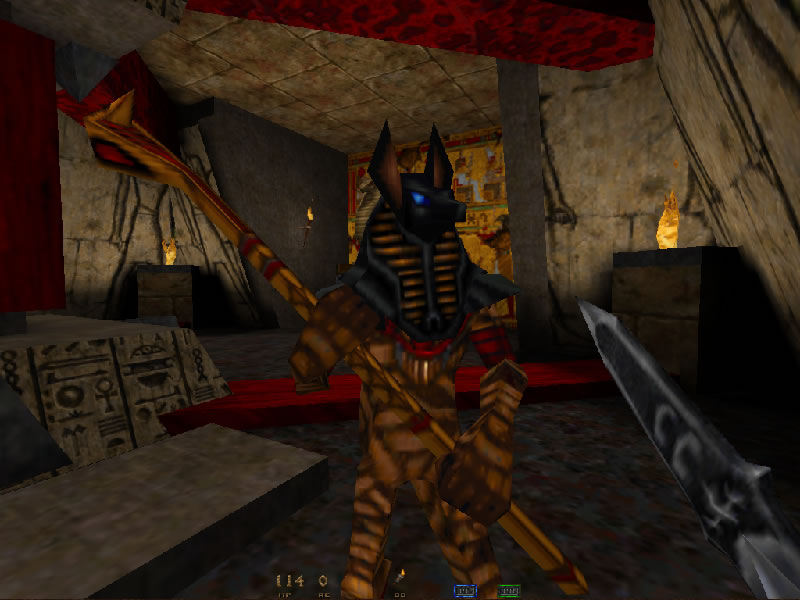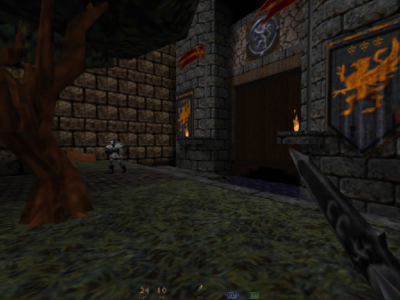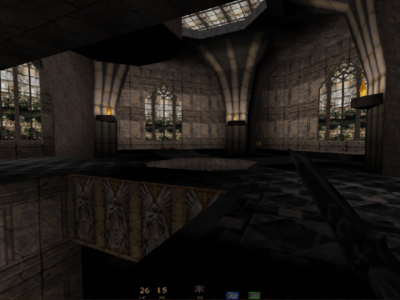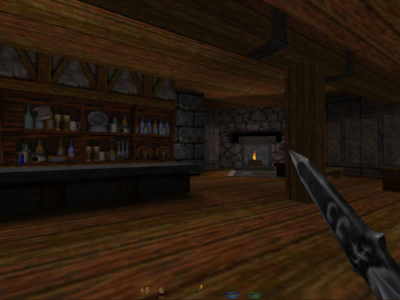
Hexen 2
Written by: Stoo
Date posted: July 8, 2006
- Genre: Action
- Developed by: Raven
- Published by: Activision
- Year released: 1997
- Our score: 8
Developers Raven have a long and fairly proud history of making first-person action titles, often based on game engines created by iD software. A big part of that from the the 90s consists of the Hexen and Heretic family. Heretic, based on the Doom engine, was notable for swapping the sci-fi setting for one of fantasy: elves, spells and castles. Oh, and you could look up and down too, huzzah! It wasn’t really notable for much else tho – not a bad game by any means, just rather average. In fact it was pretty much a less exciting retread of Doom, except instead of shooting imps with a shotgun, you were zapping skeletons and gargoyles with magic bolts.
The follow-up was Hexen, a more noteworthy title. It was also Doom powered, but incorporated new features like hub-based levels, moving bits of scenery, and a degree of puzzle-solving. So there was a little more to the experience than just dashing about shooting things. It also featured three playable heroes, for extra replay value. Then in 1996 a new generation was ushered in for first person gaming with the arrival of iD’s Quake engine. It brought with it true 3D environments, replacing the sort-of-psuedo-3D that had been the norm prior to that, and polygon based character models instead of flat sprites. Thus, an ideal opportunity for a Hexen sequel. Which, criminally, I’ve had sat in a drawer for the past few years after Rik passed it onto me. Well, today at least that error is corrected.
The setting: Remember the Serpent Riders? The Big Evils of the previous two games? No? I don’t blame you. Anyway, it turns out there’s another. And he’s conquered another world. So some heroes are needed to defeat him. Except he’s enlisted the four horsemen of the apocalypse – Death, War, Famine and Pestilence, no less. Each has control of a continent based on a period of earth history, so you’ll have to beat each one senseless in turn, before taking on Eidolon himself. Yeah, it’s another back-of-an-envelope token storyline. There’s a perfunctory plastic-looking pre-rendered opening animation of some bearded old guy explaining what’s what, but I’ve already forgotten most of what he says.
The format of the game remains pretty much unchanged from the first Hexen. Rather than being a simple linear series, its maps or levels are grouped into four hubs or clusters. Within each cluster you move between maps, working to unlock a path towards one of the four Horseman. You take them on in a traditional “boss fight”, and after vanquishing their evil asses, move onto the next hub. First though you must pick your hero, this time with a choice of four – Paladin, Crusader, Assassin and Necromancer. If you have the Portal of Pravus expansion you’re offered a fifth, the Demoness. Like in the first game they only get four weapons each, which might feel a little disappointing at first, but it’s not something that really bothers you once you get into it.
Each character starts out with a basic hand-to-hand attack, then upgrades to various mana-powered weapons, with a bit of variation in terms of who’s geared for a melee fight and who prefers to stay at longer range. The Paladin for example starts off with his bare fists, then gets an enchanted sword for better close-quarters fighting, and an axe that both chops up nearby foes, and hurls spinning exploding blades for anyone further away. His one dedicated ranged weapon is some kind of magic staff hurling a torrent of magical bolts. The necromancer meanwhile begins with a wimpy sickle, but then goes for a couple of spells and some kind of death-ray weapon, allowing him to keep his distance. I would have preferred maybe a few more fancy enchanted swords and crossbows (and exploding axes), and a few less “magic-bolt” types leaving the latter as the Necromancer’s speciality, but that’s just me.
Along with weapons, you have an inventory of useful artifacts you pick up along the way, to activate at an appropriate moment. For example the Tome of Power (returing from Heretic) briefly increases your weapon’s power, and the Force Cube hovers around your head for a minute or so, zapping nearby enemies. The Glyph of the Ancients meanwhile has a different effect for each hero – it’s a sticky grenade for the paladin, a time-bomb for the necromancer and a landmine for the assassin.
Your heroes also have a few innate special abilities. The Assassin can turn invisible when stationary, the crusader can self-heal, and the paladin will, if you’re lucky, occasionally cheat death and return from a killing blow fully healed and briefly at super-strength. To top all this off is a simple RPG-style character-levels system. All this really means is that, after killing enough monsters, you get increased hitpoints and mana reserves.
Anyway time to look at the first hub, which has a medieval-Europe theme. As well as castles you’re running through abandoned shops, taverns and stables, a mill and a ruined church. Even if any map is in truth just an environment for you to fight and adventure in, I always like to see locations with the illusion of having a real purpose. Flags flutter in the breeze, the windmills’s sails turn, a few remaining sheep wonder about aimlessly, and Knight Archers try to stick you full of magic arrows. Bastards. They’re accompanied by fearstome stomping golems, and little scrappy bat-imp-gargoyle creatures that have been a staple of the series since Heretic.
After that comes the Mesoamerican hub. Which I think means Aztec, more or less. It’s harder to identify the locations here, I guess mostly sacrificial temples and the like. It also features the fairly scary Werejaguars, who as well as doing slick little rolling moves to dodge your fire, can jump terrific distances. And usually slash you to bits upon landing. Then roar triumphantly. Bastards! I don’t know if they’re any more clever than average for game monsties, after all one got a bit too keen and flung himself into a lava pit. However they are certainly an enjoyable challenge to fight, taking me completely by surprise in my first encounter and leaving me running away in a cowardly fashion.
The Egyptian hub meanwhile is all about pyramids and tombs, brightly coloured and extensively decorated with paintings and statues. One cool little section sees you exploring a crumbled, ruined temple, then going back 1000 years in time to when it was in its splended prime. The top threats here meanwhile are spell-flinging anubis-headed mummies. When near destruction their arms and legs come flying off, but they keep on coming, pushing themselves with one remaining limb and trying to chew your kneecaps. Bastards.
Then the there’s Roman hub… but I won’t give it all away. The key points here are: Firstly the architecture and level design is of a consistently high standard. Quake, for all its technical advances, tended to be rather brown and monotonous, so it’s good to see Raven putting the engine to much better use. With the graphics bumped up to a high resolution, it’s all still pretty decent to look at, even if not quite as detailed or realistic as modern games. Secondly, the enemies are varied and entertaining.
As an aside, lots of items such as furniture and barrels can be destroyed. There was a classic moment where I took out a wooden support whilst trashing the tavern, only to find a heavy roof beam split and land on my head, killing me instantly. Idiot. Barrels, pottery and windows are fair game too, and if really frustrated you can even smash statues to bits. Much of this kind of interaction with scenery we might expect nowadays, but the Hexens were amongst the first to implement it.
There’s not just monsters standing in your way, though; like predecessor Hexen II brings you some puzzle solving. It’s all with the purpose of unlocking a part of a map, doing something there to grant you access to another, and so on, until you’ve finally opened the way to that hub’s Final Fight. A lot of the puzzling comes down to just finding a key, or a hidden switch, but there are some more involved cases along the way. For example in the first hub, you need to make a glass lens. Your starting material however is simply a pile of sand, so you’ll need to melt that down into a mass of glass first. Then find something to grind it with. The Egyptian hub meanwhile is probably the most complex overall in this regard.
I praised the original Hexen for taking some steps to enhance and expand the gameplay beyond the run-and-gun of Doom. This one, it has to be said, doesn’t really do anything new in turn. In fact it’s mostly a helping of more of the same, with a more advanced engine. Still, within this context it does very well, and it’s still one step more clever a game than many other shooters. The one aspect you might find lacking, compared to modern games, is the lack of any kind of integrated narrative. There’s no real story, no-one to talk to, no scripted events – the kind of things Half-Life implemented so well a few years later. Still, out of the pre-HL generation I’d rate this as one of the top shooters. It gives you a healthy dose of well-balanced action, throws some few puzzles at you without getting too mentally tortuous, and features some good level design. That’s got to be enough for a thumbs up.





 Posts
Posts